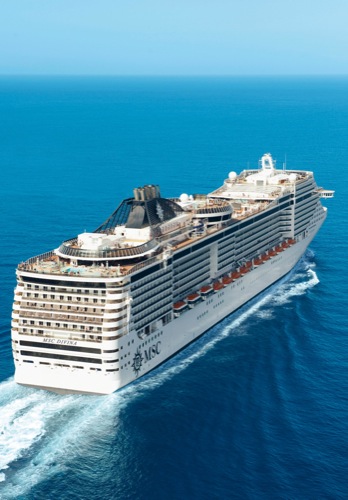
Courtesy MSC Cruises
Excursions
1) Company styles.
Major “standard” cruise lines with fleets of megaliners include Carnival, Princess, Royal Caribbean, NCL, Costa and MSC. Disney caters to families with children. “Premium” lines
Celebrity, Holland America, Cunard, Oceania and Azamara offer upgraded amenities and added elegance. “Luxury” operators Seabourn, Crystal, Regent Seven Seas, Silversea and SeaDream cater to those who demand the best.
2) Cruise length.
A one-week (seven-night) cruise is usually ideal for a first seagoing effort. Shorter three- and four-night sailings can sometimes develop an atmosphere of excessive partying and seldom
represent the best that cruising has to offer.
3) Good destinations.
The Caribbean, Mexico, Alaska and New England/Canada are all good destination choices for a first-time group cruise.
4) Deals vs. value.
Although there are bargains to be had, never make a cruise decision based solely on price; instead, always seek the greatest overall value.
5) Type of berth.
Inside cabins without windows are good for those on a limited budget but not for the claustrophobic. Outside cabins have a large window or windows. The popular — and more expensive — balcony cabins feature semiprivate verandas for outdoor relaxation.
6) Excursion choices.
Shore excursions should normally not be included in the basic group package. That would defeat a primary advantage of cruising, that of allowing for individual choice and the
pursuit of individual interests.
7) Room for gatherings.
Private meeting rooms are available at no charge for a group get-together aboard most ships. Cocktail parties, including nonalcoholic ones, can easily be arranged, or your group
members can simply plan to meet in one of the larger public lounges at a predetermined time.
8) Mind payment due dates.
Dates for the payment of deposits and final payments are not merely suggestions but a schedule established by the line that it expects to be observed. Groups ignoring such dates run the risk of having their space blocks recalled, either totally or partially.
9) Insurance recommended.
Including trip cancellation insurance in the selling price of your package is strongly recommended, as penalties for late cancellation of cruise arrangements can be severe. Usually, it makes good economic sense to obtain comprehensive travel protection coverage.
10) Passports required?
Unless plans are for a river or waterway cruise wholly within the United States or a seven-day Hawaii sailing from Honolulu, group members will need to carry passports. This includes Alaska departures from or concluding in Seattle; Vancouver, British Columbia; or San Francisco.
11) Comps available.
One complimentary cruise fare is usually provided per each 10 to 15 paid guests and can be used by the group leader, designated for special “VIP” guests or sold, as desired.
12) Timetables are important.
Make sure to allow adequate lead time before sailing to promote the cruise and allow bookings a sufficient opportunity to accumulate: A year is ideal but, normally, no less than nine months.










